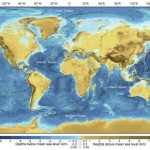For background on the EPR Chronicles, see this post. The expedition was also recorded online at the Field Museum during this time (before science blogs!) and includes dispatches, videos and photos!
Saturday 11/08 1:30am
Been a while since I made an entry. We were on station at 8°37’N and its been really busy, but real fun and exciting. Thurs. I was up at 3am to help watch the SeaBeam data come in. SeaBeam sends out a pulse signal to map a small area of the seafloor beneath the ship. I don’t think I did much, but Jim & Z wanted me there. That was pretty long morning. Jim & Todd went down in the sub around 8-9 am and did not resurface until 4 pm. I had a small nap in the afternoon, but I was up from 3 am Thursday till 5am Friday.
Thurs. night was our 1st TowCam night. we put the machine over the side of the boat around 7 pm. It appeared to be working well, but as we waited for it to travel towards the bottom, we noticed we weren’t seeing the data from the strobe lights. We waited about an hour because there was a 30 min. delay programmed. We brought it up and the techie toyed around with it and got it working properly & we put it in the water again a 9 pm. It took till 4 am to take pictures. During this time, between 9 pm – 4 am the graphs & computer monitors must be constantly watched, data must be logged every five minutes, the camera must be “flown” the whole time. The driver of the camera only watches two numbers: the distance between the camera’s bottom and the seafloor and the distance between the front of the camera and any object that may be in front (up to 100 meters away). Jim & Z & Dave, the techie, all drove it on Thurs. night. Them plus me drove it Friday night while letting Beth and Lee Hsiang have a go for 20-30 minutes.
The camera is set to take pictures every fifteen seconds and strobes. The pictures can turn out real good if the camera remains around 5 meters above the seafloor. Of course sometimes the seafloor jumps up suddenly and you end up inadvertently sampling rocks. We have some interesting pictures of Jim & hitting the bottom. We won’t be doing camera tows for a little while.
Our next site is 9°35’N & it has been studied extensively already. Breea has some experiments there she needs to check & we want to have samples of the fauna for the Museum. Janet put me on video detail. When the sub comes up, the techies make duplicates of the master for the science party. The master copies themselves go to WHOI where they will be archived. Only Janet and I have access to the duplicates which are essentially property of the Field Museum. I have to go through all the videos (6 2-hour videos per dive) & pick out important or interesting facts. I will also make a highlights video for everyone. That will be my new day job for the remainder of the trip & I will assist other people with their projects also.
It is exciting when the subs come up. It is a mad dash to preserve the specimens as best as possible. We run them to the cooler to keep them cold, often all these guys live in 1.82°C water and don’t like being in warm water. We’ve brought up lotsd of cool stuff such as :
1 sea star
a couple brittle stars
dozen Tevnia (tubeworms)
1 holothuroid (related to same family as sea cukes)
hundreds of amphipods
1 new species of Dahlella (a small crustacean)
maybe a new species of limpet
1 octopus which Janet dissected
1 pycnogonid (sea spider)
several other items which I cannot remember plus a few rock samples. Z thinks he found andesites near the ridge spreading centre. This type of rock is very rare on the ocean bottom and would be an important discovery in geology, but he needs to analyze the rock samples back on land in the lab to be absolutely sure. Andesites are formed when the molten rock cools longer than basalt & therefore has less Fe & Mg because they tend to drop out of a melt the slower a melt cools off. This tells us that a magma chamber was close to the surface.





